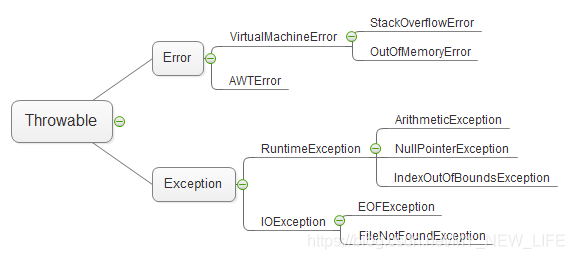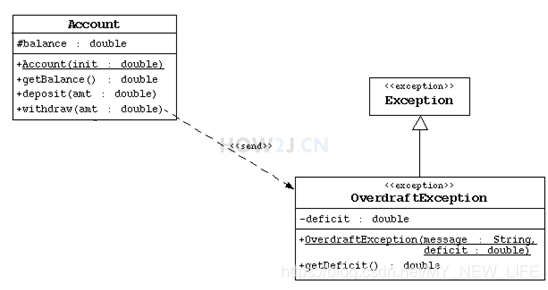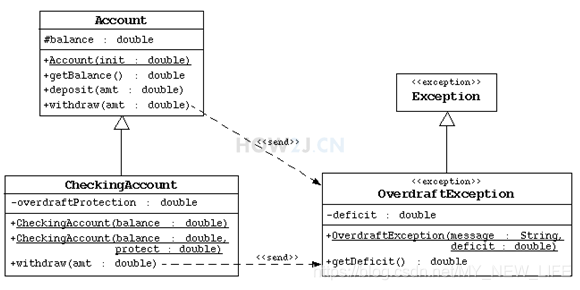Java中级内容——异常处理(exception handing)
声明:文章为https://how2j.cn/k/exception/exception-tutorial/332.html网站内容的学习笔记。里面有更加详细的视频和解读。本文仅为自己学习、练习、复习的一个参考。
一、什么是异常
异常定义:
导致程序的正常流程被中断的事件,叫做异常。
package Exception;
import java.io.File;
import java.io.FileInputStream;
import java.io.FileNotFoundException;
public class TestException {
public static void main(String[] args) {
File f = new File("d:/LOL.exe"); // 试图打开文件LOL.exe,会抛出FileNotFoundException,如果不处理该异常,就会有编译错误
try {
new FileInputStream(f);
System.out.println("LOL.exe文件正常打开");
}
catch(FileNotFoundException e) {
System.out.println("LOL.exe文件找不到,请检查");
e.printStackTrace();
}
}
}
输出结果:
LOL.exe文件找不到,请检查
java.io.FileNotFoundException: d:\LOL.exe (系统找不到指定的文件。)
at java.io.FileInputStream.open0(Native Method)
at java.io.FileInputStream.open(Unknown Source)
at java.io.FileInputStream.<init>(Unknown Source)
at Exception.TestException.main(TestException.java:13)
知识点:如何打开一个文件。注意导入的三个包File,FileInputStream,FileNotFoundException.
问题:try_catch没学过,不知道用法。
二、如何处理
异常处理常见手段: try catch finally throws
1、try catch
1.将可能抛出FileNotFoundException 文件不存在异常的代码放在try里
2.如果文件存在,就会顺序往下执行,并且不执行catch块中的代码
3. 如果文件不存在,try 里的代码会立即终止,程序流程会运行到对应的catch块中
4. e.printStackTrace(); 会打印出方法的调用痕迹,如此例,会打印出异常开始于TestException的那一行,这样就便于定位和分析到底哪里出了异常。Stack指的是栈调用,从输出的结果信息最下面层层调用。
2、使用异常的父类进行catch
FileNotFoundException是Exception的子类,使用Exception也可以catch住FileNotFoundException。
问题:
1.按F3查看FileNotFoundException源文件时,出现the jar file has no source attachment,无法查看源码。参考解决方法,顺利解决问题。
2.输出结果显示中有Unknown Source,无法查找到源码中对应的程序。
package Exception;
import java.io.File;
import java.io.FileInputStream;
import java.io.FileNotFoundException;
public class TestException {
public static void main(String[] args) {
File f = new File("d:/LOL.exe"); // 试图打开文件LOL.exe,会抛出FileNotFoundException,如果不处理该异常,就会有编译错误
try {
new FileInputStream(f);
System.out.println("LOL.exe文件正常打开");
}
//catch(FileNotFoundException e) {
catch(Exception e) {
System.out.println("LOL.exe文件找不到,请检查");
e.printStackTrace();
}
}
}
3、多异常捕捉办法1
解决办法之一是分别进行catch,把可能出现问题的代码都放在try里面,然后分别进行catch。
注意:如果第二个catch是ParseException,则前面的catch不能是Exception而需要用FileNotFoundException,否则会出现错误Unreachable catch block for ParseException. It is already handled by the catch block for Exception。
package Exception;
import java.io.File;
import java.io.FileInputStream;
import java.io.FileNotFoundException;
import java.text.ParseException;
import java.text.SimpleDateFormat;
import java.util.Date;
public class TestException {
public static void main(String[] args) {
File f = new File("d:/LOL.exe"); // 试图打开文件LOL.exe,会抛出FileNotFoundException,如果不处理该异常,就会有编译错误
try {
new FileInputStream(f);
System.out.println("LOL.exe文件正常打开");
SimpleDateFormat sdf = new SimpleDateFormat("yyyy-MM-dd");
Date d = sdf.parse("2016-09-27");
}
catch(FileNotFoundException e) {
System.out.println("LOL.exe文件找不到,请检查");
e.printStackTrace();
}
catch (ParseException e) {
System.out.println("日期格式解析错误");
e.printStackTrace();
}
}
}
4、多异常捕捉办法2
另一个种办法是把多个异常,放在一个catch里统一捕捉。这种方式从 JDK7开始支持,好处是捕捉的代码更紧凑,不足之处是,一旦发生异常,不能确定到底是哪种异常,需要通过instanceof 进行判断具体的异常类型。
注意:只需要写一个e.printStackTrace();就行。e引用所指对象为catch括号中错误类型对象。
package Exception;
import java.io.File;
import java.io.FileInputStream;
import java.io.FileNotFoundException;
import java.text.ParseException;
import java.text.SimpleDateFormat;
import java.util.Date;
public class TestException {
public static void main(String[] args) {
File f = new File("d:/LOL.exe"); // 试图打开文件LOL.exe,会抛出FileNotFoundException,如果不处理该异常,就会有编译错误
try {
new FileInputStream(f);
System.out.println("LOL.exe文件正常打开");
SimpleDateFormat sdf = new SimpleDateFormat("yyyy-MM-dd");
Date d = sdf.parse("2016-09-27");
}
catch (FileNotFoundException | ParseException e) {
if (e instanceof FileNotFoundException) {
System.out.println("LOL.exe文件找不到,请检查");
}
if (e instanceof ParseException) {
System.out.println("日期格式解析错误");
}
e.printStackTrace();
}
}
}
5、finally(面试考察点)
无论是否出现异常,finally中的代码都会被执行。比如用来执行数据库的关闭工作,无论前面是否运行正常,finally都会将其关闭。
package Exception;
import java.io.File;
import java.io.FileInputStream;
import java.io.FileNotFoundException;
import java.text.ParseException;
import java.text.SimpleDateFormat;
import java.util.Date;
public class TestException {
public static void main(String[] args) {
File f = new File("d:/LOL.exe"); // 试图打开文件LOL.exe,会抛出FileNotFoundException,如果不处理该异常,就会有编译错误
try {
new FileInputStream(f);
System.out.println("LOL.exe文件正常打开");
SimpleDateFormat sdf = new SimpleDateFormat("yyyy-MM-dd");
Date d = sdf.parse("2016-09-27");
}
catch (FileNotFoundException | ParseException e) {
if (e instanceof FileNotFoundException) {
System.out.println("LOL.exe文件找不到,请检查");
}
if (e instanceof ParseException) {
System.out.println("日期格式解析错误");
}
e.printStackTrace();
}
finally {
System.out.println("无论文件是否打开,它都会被执行");
}
}
}
6、throws
考虑如下情况:
主方法调用method1
method1调用method2
method2中打开文件
method2中需要进行异常处理
但是method2不打算处理,而是把这个异常通过throws抛出去
那么method1就会接到该异常。 处理办法也是两种,要么是try catch处理掉,要么也是抛出去。
method1选择本地try catch住 一旦try catch住了,就相当于把这个异常消化掉了,主方法在调用method1的时候,就不需要进行异常处理了。
package Exception;
import java.io.File;
import java.io.FileInputStream;
import java.io.FileNotFoundException;
import java.text.ParseException;
import java.text.SimpleDateFormat;
import java.util.Date;
public class TestException {
public static void main(String[] args) {
method1();
}
private static void method1() {
try {
method2();
}
catch(FileNotFoundException e) {
e.printStackTrace();
}
}
private static void method2() throws FileNotFoundException {
File f = new File("d:/LOL.exe");
System.out.println("试图打开 d:/LOL.exe");
new FileInputStream(f);
System.out.println("成功打开");
}
}
问题:
假设有一个方法 public int method(), 会返回一个整数
在这个方法中有try catch 和 finally.
try 里返回 1
catch 里 返回 2
finally 里 返回3
那么,这个方法到底返回多少?
无论try代码块中是否有异常,finally里的代码都会执行。try和catch代码块中有return语句时,finally仍然会执行。如果try…catch…finally都有return语句,则等待try catch执行完之后,跳过try catch里的return语句只执行finally中的return语句。如果仅仅是try…catch里有return语句,那么在执行return语句之前会先执行finally代码块里的内容。
7、throw和throws的区别
throws与throw这两个关键字接近,不过意义不一样,有如下区别:
- throws 出现在方法声明上,而throw通常都出现在方法体内。
- throws 表示出现异常的一种可能性,并不一定会发生这些异常;throw则是抛出了异常,执行throw则一定抛出了某个异常对象。
三、异常分类
异常分类: 可查异常,运行时异常和错误3种,运行时异常和错误又叫非可查异常。
1、可查异常
可查异常: CheckedException
可查异常即必须进行处理的异常,要么try catch住,要么往外抛,谁调用,谁处理,比如 FileNotFoundException,如果不处理,编译器,就不让你通过。
package Exception;
import java.io.File;
import java.io.FileInputStream;
import java.io.FileNotFoundException;
import java.text.ParseException;
import java.text.SimpleDateFormat;
import java.util.Date;
public class TestException {
public static void main(String[] args) {
File f = new File("d:/LOL.exe");
try {
System.out.println("试图打开 d:/LOL.exe");
new FileInputStream(f);
System.out.println("成功打开");
} catch (FileNotFoundException e) {
System.out.println("d:/LOL.exe不存在");
e.printStackTrace();
}
}
}
2、运行时异常
运行时异常RuntimeException指: 不是必须进行try catch的异常
常见运行时异常:
除数不能为0异常:ArithmeticException
下标越界异常:ArrayIndexOutOfBoundsException
空指针异常:NullPointerException
在编写代码的时候,依然可以使用try catch throws进行处理,与可查异常不同之处在于,即便不进行try catch,也不会有编译错误
Java之所以会设计运行时异常的原因之一,是因为下标越界,空指针这些运行时异常太过于普遍,如果都需要进行捕捉,代码的可读性就会变得很糟糕。
public static void main(String[] args) {
//任何除数不能为0:ArithmeticException
int k = 5/0;
//下标越界异常:ArrayIndexOutOfBoundsException
int j[] = new int[5];
j[10] = 10;
//空指针异常:NullPointerException
String str = null;
str.length();
}
3、错误
错误Error,指的是系统级别的异常,通常是内存用光了
在默认设置下,一般java程序启动的时候,最大可以使用16m的内存
如例不停的给StringBuffer追加字符,很快就把内存使用光了。抛出OutOfMemoryError
与运行时异常一样,错误也是不要求强制捕捉的
package Exception;
public class TestException {
public static void main(String[] args) {
StringBuffer sb = new StringBuffer();
for (int i = 0; i < Integer.MAX_VALUE; i++) {
sb.append('a');
}
}
}
Exception in thread "main" java.lang.OutOfMemoryError: Java heap space
问题:
运行时异常 RuntimeException,能否被捕捉?
错误Error,能否被捕捉?
面试题常问题: 运行时异常与非运行时异常的区别
运行时异常和错误是不可查异常,可以被捕捉,不需要进行显示的捕捉。
运行时异常是不可查异常,不需要进行显示的捕捉,非运行时异常是可查异常,必须显示的捕捉或者抛出。
四、Throwable
Throwable是类,Exception和Error都继承了该类
所以在捕捉的时候,也可以使用Throwable进行捕捉
如图: 异常分Error和Exception
Exception里又分运行时异常和可查异常。
五、自定义异常
1、创建自定义异常
package Exception;
public class EnemyHeroIsDeadException extends Exception{
public EnemyHeroIsDeadException() {
}
public EnemyHeroIsDeadException(String msg) {
super(msg);
}
}
2、抛出自定义异常
在Hero的attack方法中,当发现敌方英雄的血量为0的时候,抛出该异常
- 创建一个EnemyHeroIsDeadException实例
- 通过throw 抛出该异常
- 当前方法通过 throws 抛出该异常
在外部调用attack方法的时候,就需要进行捕捉,并且捕捉的时候,可以通过e.getMessage() 获取当时出错的具体原因
package Exception;
public class Hero {
public String name;
protected float hp;
public void attackHero(Hero h) throws EnemyHeroIsDeadException { // 方法声明时,如果方法中有throw抛出了一个异常错误,必须声明异常
if (h.hp == 0) {
throw new EnemyHeroIsDeadException(h.name + " 已经挂了,不需要施放技能"); // 通过throw抛出自定义异常类的一个实例对象,没有外部类调用它,直接new EnemyHeroIsDeadException()。
}
}
class EnemyHeroIsDeadException extends Exception { // 内部类,先创建一个自定义的异常类,里面有两个构造方法,
// 一个有参,一个无参,有参构造方法调用父类中的构造方法,输出异常相关信息
public EnemyHeroIsDeadException() {
}
public EnemyHeroIsDeadException(String msg) {
super(msg);
}
}
public static void main(String[] args) {
Hero garen = new Hero();
garen.name = "盖伦";
garen.hp = 616;
Hero teemo = new Hero();
teemo.name = "提莫";
teemo.hp = 0;
try {
garen.attackHero(teemo); // 抛出异常的方法放在try中
} catch (EnemyHeroIsDeadException e) {
// TODO Auto-generated catch block
System.out.println("异常的具体原因:" + e.getMessage()); // 获取异常相关信息
e.printStackTrace();
}
}
}
注意:首先要创建一个自定义异常,然后用throw抛出这个异常的一个实例对象,然后在方法中声明这个异常,最后对它进行捕捉。
六、异常综合练习
1、练习1
这是一个类图
Account类: 银行账号
属性: balance 余额
方法: getBalance() 获取余额
方法: deposit() 存钱
方法: withdraw() 取钱
OverdraftException: 透支异常,继承Exception
属性: deficit 透支额
知识点:
UML类图
外部类调用非静态内部类中的方法
package Exception;
public class Account {
protected double balance;
public Account(double balance) {
this.balance = balance; // 有参数的话,要将参数赋给变量
}
public double getBalance() { // 读取当前余额,不论在下面哪行调用,都能获得当时的余额情况
return balance;
}
public void deposit(double amt) { // 存钱,参数为本次存进钱的金额
this.balance += amt; // 余额当前值
}
public void withdraw(double amt) throws OverdraftException { // 取钱,如果取钱值大于余额值,抛出一个异常,告诉透支余额这条信息并且给出透支的金额
if (amt > this.balance) {
double deficit = amt - this.balance; // 计算出deficit的值
throw new OverdraftException("透支余额", deficit);// deficit给出数值或者由前面计算获得
}
}
public class OverdraftException extends Exception { // 透支余额异常
private double deficit;
public OverdraftException(String message, double deficit) {
super(message);
this.deficit = deficit;// 有参数的话,要将参数赋给变量
}
public double getDeficit() { // 获取透支金额
return deficit;
}
}
public static void main(String[] args) {
Account a = new Account(4000);
System.out.println(a.getBalance());
a.deposit(1000);
System.out.println(a.getBalance());
try {
a.withdraw(6000);
} catch (OverdraftException e) {
System.out.println("透支金额: " + e.getDeficit()); // 这里e引用是OverdraftException对象,可以调用非静态内部类中的方法getDeficit()
e.printStackTrace(); // 外部类无法直接调用非静态内部类中的方法,可以创建一个对象调用
}
}
}
2、练习2
类: CheckingAccount 支票账户,具备透支额度,继承Account
属性:overdraftProtection 透支额度
package Exception;
import Exception.Account.OverdraftException;
public class CheckingAccount extends Account{
private double overdraftProtection;//透支额度
public CheckingAccount(double balance) {
super(balance);
}
public CheckingAccount(double balance, double protect) {
super(balance);
this.overdraftProtection = protect;
}
public void withdraw(double amt) throws OverdraftException{
if(amt>this.balance +this.overdraftProtection ) {
double deficit = amt -this.balance-this.overdraftProtection;//注意deficit是重新声明的一个变量,它在外部类中
throw new OverdraftException("取钱超额", deficit);
}
this.balance -= amt;
}
public static void main(String[] args) {
CheckingAccount c = new CheckingAccount(4000, 1000); //开户存了4000,有1000的透支额
try {
c.withdraw(10000);
c.withdraw(500);
}
catch(OverdraftException e){
System.out.println(e.getDeficit());
e.printStackTrace();
}
}
}


